Growing in the open field and greenhouses of tomatoes Bovine heart
It is pleasant to grow tomatoes, the word "very" is added to all the best properties of which. Such Bovine Heart tomatoes are very large and very tasty, with a real tomato flavor. The bushes give a good harvest, thrive both under the sky and in the greenhouse. According to vegetable growers, the Bull Heart variety is one of the best.
Interesting
Oxheart tomatoes were grown in the 40s of the last century. How the variety appeared and by whom it was bred is not known for certain. According to one version, the variety is a family one, and its homeland is Novopavlovsk, Stavropol Territory, the variety is also credited with Italian, Dutch origin. It is certain that it is registered in the state register at the request of the Moscow agricultural firm Poisk. The package says that the variety is the result of folk selection.
Description and characteristics
Bull heart refers to determinant varieties medium late ripening. From the beginning of the development of the ground part to fruiting, 120-130 days pass. The bush grows up to 180 cm in height, it is powerful, with thick stems and large leaves. Requires pinching, formation, thinning of ovaries.
Fruit
The bovine heart is a large-fruited plant. The first fruits weigh 400-800 g, the later ones do not fill up to gigantic sizes. On the same bush, next to large ones, smaller tomatoes grow (the smallest - 50-100 g). On each bush, formed into one stem, there are up to 10 clusters with fruits.
The variety is distinguished by a heart-shaped shape, it is more pronounced in large fruits, in small fruits it is more rounded. Ripe fleshy tomatoes with few seeds, aromatic, sweet and sour. Basically, the Bovine Heart tomato is grown for consumption raw and for food - the fruits are too large for canning whole fruits.
Advice
Due to the thin skin, the Bovine heart is poorly stored, so it is worth laying out the fruits in one layer and not protecting them, but enjoying salads, omelets and other dishes.
The variety is time-tested and has remained popular with vegetable growers over the decades of cultivation, it is not hybrid and transfers its properties to plants planted from harvested seeds.
The disadvantages of the variety include:
- exacting care (forming a bush, creating a support, pinching, manual pollination);
- tendency to damage by late blight;
- poor keeping quality.
But the pluses outweigh, and varietal tomatoes are grown for themselves and for sale. Tomato harvest is highly dependent on climate and care. The optimistic forecast for the harvest is 5 kg per bush growing in the open field, and up to 8 kg in a greenhouse.
Subspecies diversity
Basically, the Bovine Heart is a varietal type that includes several varieties. Its subspecies practically do not differ in terms of ripening and exactingness in care, even their taste properties are similar. What sets them apart is the color of the fruit. Traditionally, bull heart tomatoes are considered red, but in varietal subspecies they are black, yellow, maroon, white, pink.
Sowing and growing seedlings
For the Ox heart, as for other tomatoes, the seedling method of growing is preferable. Seeds are sown starting from March 1, but pre-processed:
- for 12 hours placed in melt water at room temperature (it is obtained by defrosting ice specially prepared from pure oxen);
- then - in a weak solution of potassium permanganate for 45 minutes (dilute 1 g of permanganate in ½ glass of water);
- washed with warm water and dried.
For sowing, a box or plastic container is prepared, moistened fertile soil is poured into it with a layer of 3 cm. Seeds are spread into it at a distance of 2-3 cm from each other with tweezers and the base of the pencil is deepened by 1-2 cm, and sprinkled with earth on top. The container is covered with garden covering material or glass and sent to a warm room. Sowing maintenance consists of timely watering to keep the ground dry, and periodic ventilation to avoid mold.
When 2-3 leaves appear on the seedlings, the seedlings dive. In order for a young plant to be adapted to new conditions, containers with seedlings for a short time, up to several hours, are taken out to the balcony or under the open sky. The air temperature should be between + 8-12 ° C.
Seedlings up to 25 cm in height are transplanted into a greenhouse if climatic conditions permit. This usually happens in early May.
Landing in a permanent place
A sunny place is prepared for the seedlings. The earth is dug up, fertilized with humus or compost, holes up to 15 cm deep and 50 cm in diameter are made at a distance of 50 cm from each other. Before planting, top dressing is applied: complex fertilizer, organic matter. The wells are watered, and when the water is absorbed, seedling bushes are planted. The roots are buried so that the first leaves remain about 4 cm above the ground.
Important
Overgrown seedlings are buried more deeply - a second or third leaf is left above the ground.
Features of care in the greenhouse
Having moved the sprouts to protected ground, they provide the plantings with coolness and maintain the temperature within + 20-22 ° C, the greenhouse is aired daily by opening the windows.
Advice
There should be enough time for airing to evaporate the moisture deposited on the surfaces.
Tomatoes are not watered until they take root and grow. The accepted bushes are moistened by pouring water under the root and trying not to get on the plant. First, give water, based on the calculation of 5-7 l / m². As the bush grows, the volume is increased to 12 l / m², and in the heat it is brought to 15 liters. Plants can handle the heat by manually spraying water in large drops over the tops of the bushes.
Important
Water for tomatoes must be defended, and poly is carried out in the morning or evening.
Since insects rarely fly into the greenhouse, the bushes pollinate by shaking off pollen from one flowering brush to another, daily hitting the trellis 2-3 times.
Bushes form in 1 shoot, tie up a week after planting, pinch the top of the shoot, when 7-8 fruit brushes grow on the bush.
Top dressing
During the period of development, the plant is fed 3-4 times with mineral fertilizers or organic matter (they are recommended to alternate).
- The first fertilizer is applied during watering 2-3 weeks after planting the seedlings. Top dressing is aimed at rooting and growth of the bush, therefore, nitrogen must be included in the composition.
- The 2nd fertilizer is given 10 days after the first, when the plant is getting ready to bloom. Choose a nutrient mixture that promotes abundant flowering.
- The 3rd fertilizer is poured in at least 2 months before harvest. Preference is given to universal mixtures, or to support fruiting.
Of mineral fertilizers, three-element (N + P + K) universal complexes are used, special compositions for growing tomatoes.
Vegetable growers, who have long been dealing with tomatoes in greenhouses, share other feeding schemes:
- The first is done 2 weeks after planting the seedlings. A composition with a predominant content of nitrogen is introduced.
- The next two are given with an interval of 10 days during the flowering of the first clusters. For feeding, choose a composition with a high phosphorus content (n: p: k - 1: 5: 1).
- The 4th and 5th feeding is done with mixtures with a high potassium content (n: p: k - 1: 0.5: 1.7) during the growth of tomatoes on the first clusters and the formation of ovaries on the later ones.
- The next fertilization falls on flowering 5-6 brushes.A three-element fertilizer is applied (n: p: k - 1: 5: 1).
- During harvest, with an interval of 7-10 days, the plant is fed with a nutrient mixture with a high potassium content and without nitrogen (n: p: k - 0: 0.5: 1.7).
If the gardener is categorically against mineral fertilizers, the plant can be fed with one organic matter according to the scheme:
- In order for the plant to gain a green mass, a solution is prepared by adding 0.5 liters of manure and 1 tbsp to 10 liters of water. l. nitrophosphate.
- During flowering, a nutrient mixture is introduced, which is prepared by dissolving 1 part of chicken manure in 15 parts of water.
- Fertilizer for the third feeding is prepared according to the recipe: add 1 share of mullein to 10 parts of water for irrigation and mix well.
In order not to overfeed the plants and not disrupt normal development, you need to monitor the state of the plantings. The appearance of tomato bushes clearly enough indicates an excess or lack of nutrients:
- Excessively fleshy stem and large green leaves grow with excess nitrogen. The situation is fraught with rare flowering with a small number of ovaries. Accordingly, you will not have to count on a bountiful harvest.
- Nitrogen deficiency affects the slow development of the bush, the plant turns out to be weak, which also does not contribute to productivity.
- Due to the lack of potassium and phosphorus, the flowering is not abundant, there are few ovaries, the fruits ripen small.
Diseases
In terms of susceptibility to tomato diseases, the Bovine Heart variety is medium resistant.
With late blight, fungal infection, the fruits, stem, leaves become covered with brown spots. The spores of the fungus enter the greenhouse with the soil. When grown outdoors, they come from potato bushes. Therefore, it is recommended that these two crops be grown apart from each other. If late blight is detected, the bushes are treated with Bordeaux liquid, a solution of Fundazol or Fitosporin. For the prevention of the disease, planting on a leaf is treated with a garlic solution.
Macrosporiosis, which is dangerous for tomatoes, reveals itself with brown spots throughout the plant. Without treatment, the leaves and trunk die off, and the plant dies. To stop the spread of the fungal infection, the affected parts are removed and burned. Sick bushes are treated with a solution prepared from 10 liters of water, 20 g of copper sulfate and 200 g of grated laundry soap.
Important
The source of the fungal infection is the ground, and the easiest way for infection is through the wounds made when cutting the stems during the formation of a bush or pinching. Therefore, it is important to comply with agrotechnical standards and work with disinfected garden tools.
The insidious disease Fusarium wilt of tomatoes is of fungal origin and affects weak and young bushes. First, the veins of the leaves brighten, then the whole plate. The fusarium oxisporum mushroom that has settled in the plant multiplies, and the infection covers an ever larger part of the plant, toxins poison the green organism, which leads to death. At the first signs of the disease, the bush is dug up and burned near the greenhouse. All work is done carefully so as not to infect other plantings. The land in the vacant place is treated with "Fundazol" or "Fitosporin".Prevention and disinfection of soil
If in open ground plants are subject to different climatic manifestations, then in greenhouses high humidity, stagnant air, etc. become unfavorable factors.
Compliance with the rules helps to grow a bountiful harvest:
- you need to frequently change the soil for tomatoes, preferably annually, or plant tomatoes in another place with a return to the previous one after 3-4 years;
- observe the temperature regime + 22-24 ° C during the day and + 16-18 at night;
- keep air humidity not higher than 65%;
- exclude abundant watering;
- in the hot season, paint over the glass with chalk;
- the tomato greenhouse should not be built in the place where the potatoes were previously grown.
Protect yourself from tomato diseases helps disinfecting the soil:
- before planting seedlings, the soil is disinfected with a solution of copper sulfate (70 g of substance per bucket of water);
- to prevent fusarium, chalk or dolomite flour is introduced into the ground;
- in summer, to prevent fusarium wilt of tomatoes, the bushes are abundantly watered once (with moistening of the entire root system) with a solution of potassium permanganate and boric acid;
- in the fall, the soil is treated with a solution of potassium permanganate, the soil is powdered with a mixture of ash and powdered sulfur.
Outdoor cultivation
Bull's heart tomato bushes are powerful. To provide them with the necessary nutrition, the soil is fertilized in the fall - when the beds are dug up, manure is scattered on the ground at the rate of 4 kg per 1 m². Before the spring digging, the same amount of rotted manure is also scattered, only 1 tbsp is added to it. l. potassium chloride and 5 tbsp. l. superphosphate.
In early June, seedlings are planted in open ground. Growing bushes are watered abundantly 2 times a week. In dry season - more often. Top dressing is applied, as in greenhouse cultivation, 3 times.
Bovine heart tomatoes are grown in the greenhouse and in the open field. The variety is fruitful, among the tomatoes taken from the bush there are giants and small, weighing up to 100 g, fruits. You can eat vegetables, they are so tasty, and put them on the preparations. Varietal tomatoes are moderately disease-resistant and require manual pollination in the greenhouse, pinching, bush formation, and garter. Growing the variety is time consuming, but its pros outweigh the cons, and the folk variety remains popular.
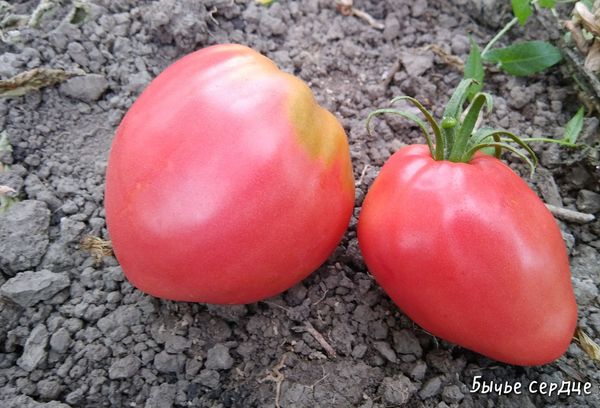
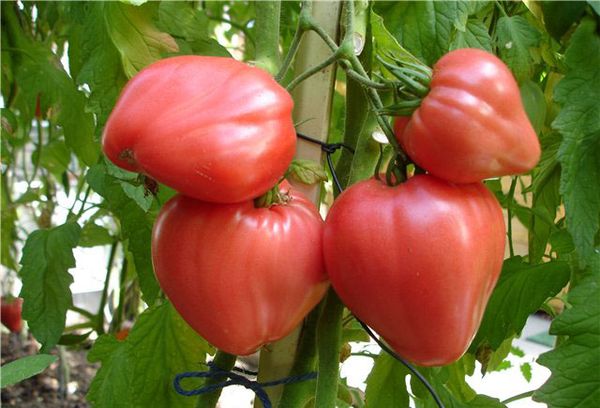
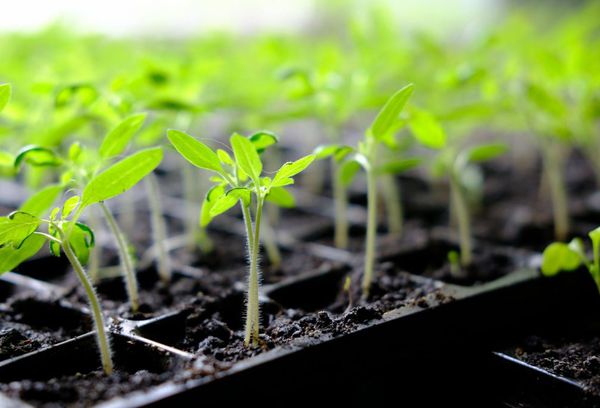


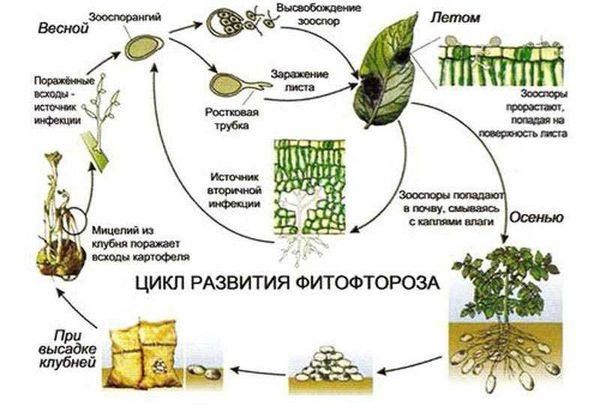
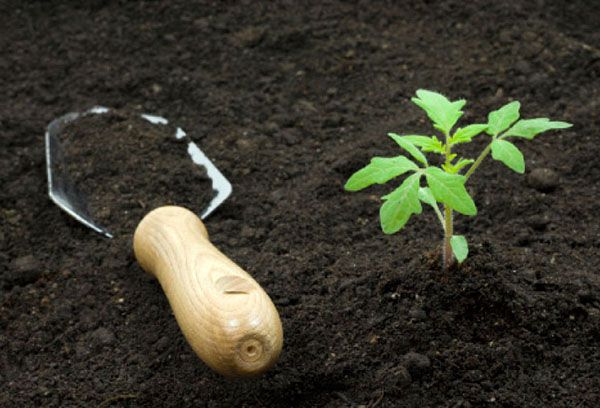

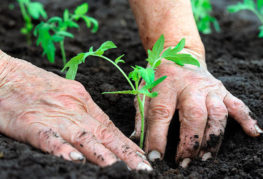

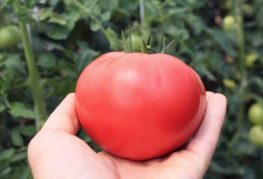
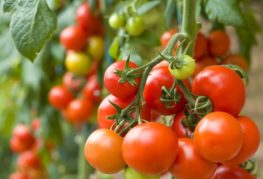
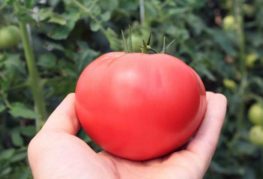
and will be published shortly.